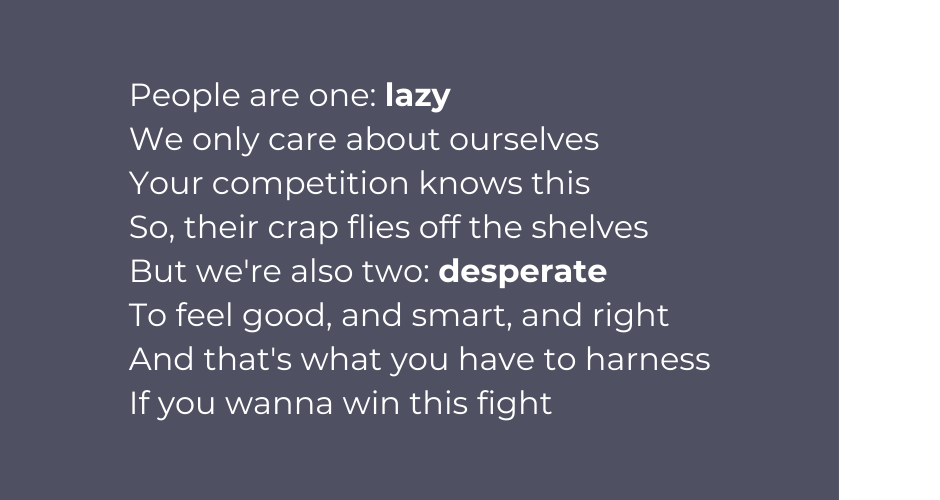Boost your marketing muscle with consumer psychology
- Amber Davis
- Feb 10
- 4 min read
Updated: Mar 24
The secret to effective marketing is asking the question: Why?
Why do people read some ads, some emails, some pop-ups and not others? Why do they watch some commercials all the way through and skip others as soon as that skip button appears? Why do people in your target audience click on what they click on and buy what they buy?
It’s a question that leads to better writing, better design, better campaign strategy, and more. Once you ask the question, you can’t take it back—and it’s pretty hard to justify ignoring the answers if you want your marketing efforts to succeed.
Analytics can tell you if your marketing efforts are effective—read rates, click-throughs, impressions—but they can’t tell you why.
The field of consumer psychology is built on that why. Consumer psychologists identify the cognitive patterns behind consumer behavior and then leverage that knowledge to increase brand or product awareness, engagement, and—ultimately—sales.
Have you ever seen "Spirited"—that Christmas musical movie with Will Ferrel, Octavia Spencer, and Ryan Reynolds? Fairly early in the movie Ryan Reynolds’ character—the evil corporate marketing-and-PR puppet master—performs a swingy, show-stopping number in front of a conference of Christmas tree growers. The song is all about tapping into people’s fears and insecurities in order to boost sales of real trees over artificial trees.
Here’s a snip of the lyrics:
It’s a super-catchy yet horrifying example of the power that comes with understanding consumer behavior. But—while Ryan Reynolds and his full brass band apply that power to stoke hate and create division, and we at Mix deploy that power in other, some might say better, kindlier ways—he’s not technically wrong. He’s answering the question in the Christmas tree growers’ minds: Why are people buying artificial trees? What reason can we give them to buy a real tree?
Consumers behave predictably, and they want to feel something when they interact with marketing content. Happiness, relief, excitement, inspiration—as marketers we can use psychology to elicit these emotions through savvy application in messaging, branding, and design.
Lightening the cognitive load with storytelling
Cognitive Load Theory posits that the human working memory has limited capacity—a maximum duration of about 20 seconds. At this same time our working memories have the ability to recall about seven things in a list and can concurrently process (consider and compare) two to four chunks of information at once.1
As marketers, what do we do with that? First, we organize our message in a hierarchical information flow—also known as a good story—leading with the most important piece of information first and never overwhelming the consumer with too many things to remember all at once.
Then, we present that message in a well-structured visual hierarchy that reduces cognitive load by supporting the logical flow of information with design principles that tap into our emotional impulses and processing habits. The reduced cognitive load prepares consumers to access their emotions because they feel at ease.
In his book, Thinking, Fast and Slow, psychologist Daniel Kahneman introduces the data-based theory of System 1 (intuitive) and System 2 (analytical) thinking.2 For consumers in an intuitive thinking mode—fast, automatic, and emotion-driven—a clear visual hierarchy connects by guiding immediate, instinctive reactions.
For those in analytical thinking mode—slower and more deliberate—users engage with the detail after their attention is initially captured by strong visual cues. Hierarchical design bridges these two processes by leading the consumer from a first impression to a deeper understanding.
Appealing to the subconscious with design
Science confirms that visual cues and structure are critical to the way people consume, process, and retain information. In the 1920s, a set of concepts known as Gestalt principles helped introduce the idea that human perception is heavily influenced by our motivations and expectations. This school of thought became a significant foundational influence for the development of modern design principles like repetition and proximity.3
Design principles like contrast, size, and color address issues of selective attention—the idea that consumers can only focus on a limited amount of information at one time. Other design tactics like a bright color or a bold font display what psychologists call pre-attentive attributes: they are processed almost instantly, even before conscious awareness. Your design can leverage these attributes to signal what’s important and help reduce cognitive load for your content consumer.4
When we lighten their cognitive load and information is easier to process, consumers feel engaged and relieved and are more likely to fully engage and make buying decisions.
Eliciting emotions with color
Choosing the right color palette for a brand, product, or piece of marketing content is one of the simplest things any marketer can do to purposefully elicit a specific emotional response in their target consumer.
While the emotional effects of colors may be influenced by culture, age, and geography, “one 2020 study that surveyed the emotional associations of 4,598 people from 30 different countries found that people commonly associate certain colors with specific emotions.”5
The results of that study show that some color-emotion connections can transcend demographic differences.



Putting it all to work
Now that you’ve asked the critical question why, you can leverage what you learn from these consumer psychology concepts and others to understand consumer behavior and get better results from your marketing efforts.
Lighten the cognitive load, tell a story, appeal to the subconscious, elicit a targeted emotion.
Maybe do it through a jazzy tap-dance number, if you feel so inclined. We’re here for it.






Comments